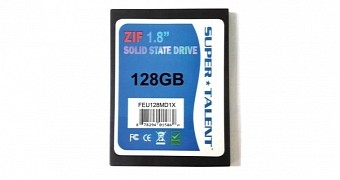At this point, most storage devices used in computers and servers use the SATA interface or derivatives of it, or PCI Express in fewer cases. However, that does not mean that the IDE technology has been left in the dust.
It appears that a number of enterprise computing, medical system and aerospace applications are still quite fond of IDE-based hard disk drives and solid state drives.
SSDs are still quite underrepresented there, however, mostly because the IDE connection just can't live up to what NAND can do in terms of read and write performance.
On the other hand, the latest 40-pin Zero Insertion Force connector with IDE interface can be fitted in very small SSDs if engineers know what they're doing.
Super Talent has just released an SSD that illustrates this as well as could possibly be hoped: the DuraDrive ZT4.
Super Talent DuraDrive ZT4 SSD
The SSD is a successor to the DuraDrive ZT3 and uses that very 40-pin Zero Insertion Force connector with an IDE interface, as we mentioned previously.
The SSD measures 51.8 x 69.8 x 5.0 mm / 2.03 x 2.74 x 0.19 inches and is made of MLC NAND Flash chips (multi-level cell).
Performance-wise, they aren't something to write home about, as the read speed is limited to 110 MB/s and the writing speed can't go above 90 MB/s.
On the other hand, the IDE interface will allow them to integrate in legacy, older system and server conglomerates, allowing the existing infrastructure to be used at its best.
The internal cache size is of 180 MB by the way, while the storage capacity is of 16 GB to 256 GB. All in a 1.8-inch form factor.
It is interesting to note that HDDs in 1.8-inch size are actually more prevalent than SSDs. The Super Talent DuraDrive ZT4 should, thus, fill in a gap, of sorts, between 2.5-inch SSDs and memory cards, in terms of physical size at least.
Availability and pricing
Super Talent did not specify the price range, but that is probably because the cost will depend on order size, warranty needs, support, haggling, etc. Things at corporate level are a bit more fluid in this regard than on the consumer retail front.

 14 DAY TRIAL //
14 DAY TRIAL //